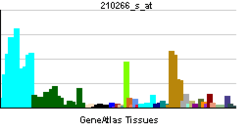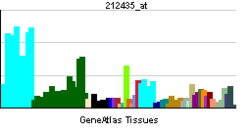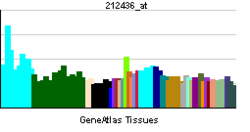TRIM33
Tripartite motif-containing 33 (TRIM33) also known as transcriptional intermediary factor 1 gamma (TIF1-γ), is a human gene.[1][2]
The protein encoded by this gene is thought to be a transcriptional corepressor. However unlike the related TIF1-α and TIF1-β proteins, few transcription factors such as Smad4 that interact with TIF1-γ have been identified.[1]
Structure
The protein is a member of the tripartite motif family.[3] This motif includes three zinc-binding domains:
- RING
- B-box type 1 zinc finger
- B-box type 2 zinc finger
and a coiled-coil region.
Three alternatively spliced transcript variants for this gene have been described, however, the full-length nature of one variant has not been determined.[1]
Interactions
TRIM33 has been shown to interact with TRIM24.[4]
Role in cancer
TRIM33 acts as a tumor suppressor gene preventing the development chronic myelomonocytic leukemia.[5] TRIM33 acts as an oncogene by preventing apoptosis in B-cell leukemias.[6]
References
- ↑ 1.0 1.1 1.2 "Entrez Gene: TRIM33 tripartite motif-containing 33".
- ↑ Venturini L, You J, Stadler M, Galien R, Lallemand V, Koken MH, Mattei MG, Ganser A, Chambon P, Losson R, de Thé H (February 1999). "TIF1gamma, a novel member of the transcriptional intermediary factor 1 family". Oncogene 18 (5): 1209–17. doi:10.1038/sj.onc.1202655. PMID 10022127.
- ↑ Reymond A, Meroni G, Fantozzi A, Merla G, Cairo S, Luzi L, Riganelli D, Zanaria E, Messali S, Cainarca S, Guffanti A, Minucci S, Pelicci PG, Ballabio A (May 2001). "The tripartite motif family identifies cell compartments". EMBO J. 20 (9): 2140–51. doi:10.1093/emboj/20.9.2140. PMC 125245. PMID 11331580.
- ↑ Peng, Hongzhuang; Feldman Irina; Rauscher Frank J (Jul 2002). "Hetero-oligomerization among the TIF family of RBCC/TRIM domain-containing nuclear cofactors: a potential mechanism for regulating the switch between coactivation and corepression". J. Mol. Biol. (England) 320 (3): 629–44. doi:10.1016/S0022-2836(02)00477-1. ISSN 0022-2836. PMID 12096914.
- ↑ PMID 21537084 (PubMed)
Citation will be completed automatically in a few minutes. Jump the queue or expand by hand - ↑ PMID 25919951 (PubMed)
Citation will be completed automatically in a few minutes. Jump the queue or expand by hand
Further reading
- Venturini L; You J; Stadler M et al. (1999). "TIF1gamma, a novel member of the transcriptional intermediary factor 1 family". Oncogene 18 (5): 1209–17. doi:10.1038/sj.onc.1202655. PMID 10022127.
- Klugbauer S, Rabes HM (1999). "The transcription coactivator HTIF1 and a related protein are fused to the RET receptor tyrosine kinase in childhood papillary thyroid carcinomas". Oncogene 18 (30): 4388–93. doi:10.1038/sj.onc.1202824. PMID 10439047.
- Kikuno R; Nagase T; Ishikawa K et al. (1999). "Prediction of the coding sequences of unidentified human genes. XIV. The complete sequences of 100 new cDNA clones from brain which code for large proteins in vitro". DNA Res. 6 (3): 197–205. doi:10.1093/dnares/6.3.197. PMID 10470851.
- Reymond A; Meroni G; Fantozzi A et al. (2001). "The tripartite motif family identifies cell compartments". EMBO J. 20 (9): 2140–51. doi:10.1093/emboj/20.9.2140. PMC 125245. PMID 11331580.
- Peng H, Feldman I, Rauscher FJ (2002). "Hetero-oligomerization among the TIF family of RBCC/TRIM domain-containing nuclear cofactors: a potential mechanism for regulating the switch between coactivation and corepression". J. Mol. Biol. 320 (3): 629–44. doi:10.1016/S0022-2836(02)00477-1. PMID 12096914.
- Yoon HG; Chan DW; Reynolds AB et al. (2003). "N-CoR mediates DNA methylation-dependent repression through a methyl CpG binding protein Kaiso". Mol. Cell 12 (3): 723–34. doi:10.1016/j.molcel.2003.08.008. PMID 14527417.
- Ota T; Suzuki Y; Nishikawa T et al. (2004). "Complete sequencing and characterization of 21,243 full-length human cDNAs". Nat. Genet. 36 (1): 40–5. doi:10.1038/ng1285. PMID 14702039.
- Brandenberger R; Wei H; Zhang S et al. (2005). "Transcriptome characterization elucidates signaling networks that control human ES cell growth and differentiation". Nat. Biotechnol. 22 (6): 707–16. doi:10.1038/nbt971. PMID 15146197.
- Dupont S; Zacchigna L; Cordenonsi M et al. (2005). "Germ-layer specification and control of cell growth by Ectodermin, a Smad4 ubiquitin ligase". Cell 121 (1): 87–99. doi:10.1016/j.cell.2005.01.033. PMID 15820681.
- Gregory SG; Barlow KF; McLay KE et al. (2006). "The DNA sequence and biological annotation of human chromosome 1". Nature 441 (7091): 315–21. doi:10.1038/nature04727. PMID 16710414.
- He W; Dorn DC; Erdjument-Bromage H et al. (2006). "Hematopoiesis controlled by distinct TIF1gamma and Smad4 branches of the TGFbeta pathway". Cell 125 (5): 929–41. doi:10.1016/j.cell.2006.03.045. PMID 16751102.
External links
- TRIM33 protein, human at the US National Library of Medicine Medical Subject Headings (MeSH)
This article incorporates text from the United States National Library of Medicine, which is in the public domain.
| ||||||||||||||||||||||||||||


